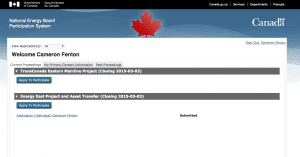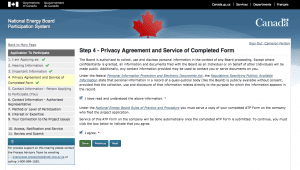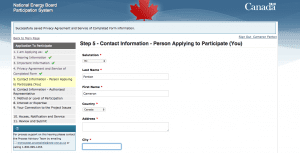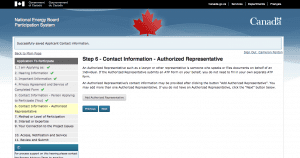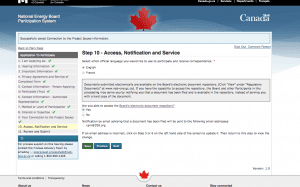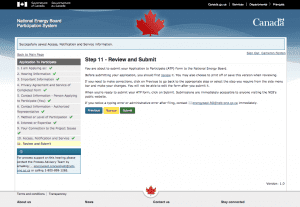Download the pdf versions of this guide (and the tables referenced in Step 12).
Step 1: Start by Clicking Here
Step 2: Select GCkey Login and follow the instructions to create an account
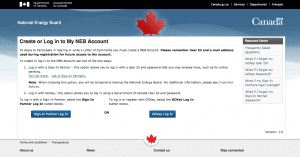
Step 3: Follow the link to create your account on the NEB website
Step 4: Click Apply to Participate in the “Energy East Project and Asset Transfer” heading
Step 5: Select Individual (unless you are applying as a group or organization)
Step 6: Read and click Next through steps 1 through 4 in the application
Step 7: Fill out your contact information for yourself (this should be auto-filled from your account)
Step 8: Skip adding an Authorized Representative, or if you want, you can add the Conservation Council of New Brunswick as an Authorized Representative to communicate with the NEB.
Contact information: Tracy Glynn, Conservation Council of New Brunswick, 180 Saint John St., Fredericton, NB E3B 4A9, tracy.glynn@conservationcouncil.ca. This is optional but may help us track applications if the NEB follows up with us.
Step 9
Individuals, groups, or organizations can either participate in the hearing by writing a letter of comment or by acting as an intervenor.
A letter of comment (commenter) allows an individual or organization to share their views on the pipeline in writing and to propose conditions on whether or not the project should be approved.
Intervenors may, as individuals or groups, file written evidence, ask written questions about TransCanada’s evidence, file and respond to notices of motion, comment on draft conditions, and present written and oral arguments. An intervenor is usually more heavily involved in the public hearing process than a commenter and as such should be prepared to make a much more significant time commitment. Those who participate as intervenors are also eligible for participant funding and access to board process advisors.
Step 10
Before the NEB will allow an individual to participate as an intervenor or submit a letter of comment, the individual must show:
1. They are directly affected by the granting or refusing of a pipeline application.
Examples showing a person is directly affected by the pipeline could include, but are not limited to:
· A commercial, property or financial (including employment) interest
· Personal use and occupancy of land and resources
· Use of land and resources for traditional Aboriginal purposes
AND/OR
2. They have relevant information or expertise for the Board to consider in its review of the pipeline application.
When deciding if a person has relevant information, the board will consider:
· The source of the person’s knowledge
· The extent to which the information is within the project scope and related to the list of issues
· How much value the information will add to the Board’s decision
When deciding if a person or group has relevant expertise, the board will consider:
· The person’s qualifications
· The extent to which the person’s expertise is within the project scope and related to the list of issues
· How much value the information will add to the board’s decisions or recommendation
In order to increase the likelihood of having a letter of comment accepted or participating as an intervenor, it is beneficial for any applicant to qualify for as many categories as reasonably possible.
Step 11
Select the issues related to the pipeline you believe are most applicable. Generally, the more issues you are able to select and tie in to your application, the better. While you can choose whatever you feel is most relevant, CCNB suggests including the following issues:
1 – The need for the project.
2 – The economic feasibility of the project.
7 – The potential environmental and socio-economic effects of the project, including the environmental effects of accidents or malfunctions that may occur in connection with the project, and any cumulative effects that are likely to result from the project, as considered under the Canadian Environmental Assessment Act, 2012.
8 – The potential environmental and socio-economic effects of increased marine shipping.
11 – Potential impacts of the project on Aboriginal interests.
12 – Potential impacts of the project on directly affected landowners and their land use.
13 – Safety and security associated with the construction and operation of the project, including emergency response planning and third-party damage prevention.
14 – Contingency planning for spills, accidents, or malfunctions during construction and operation of the project.
While an individual should attempt to include as many reasons as possible as to why the pipeline should not proceed, the NEB will not look at any issues not included on the pre-determined list in step 11. For example, the NEB will not hear any arguments related to climate change. In order for an effective application, it is advised to only address the issues listed by the NEB.
Step 12
To help you complete Step 9 of the NEB Energy East application form (Your Connection to the Project Issues), the Conservation Council of New Brunswick has put together a list of some of the explanations individuals and groups in B.C. used recently to have their applications to participate in a different NEB hearing for the Kinder Morgan pipeline approved by the NEB.
We believe that if you read through the examples provided, you will find wording or ideas you can use to complete your application to participate in the NEB Energy East pipeline hearing.
In the tables below, we have arranged these example explanations under the categories of “directly affected” and “relevant knowledge and/or expertise” and by the NEB’s List of Issues for the Energy East pipeline.
Directly affected
Issue 7: The potential environmental and socio-economic effects of the proposed project, including the environmental effects of accidents or malfunctions that may occur in connection with the project, and any cumulative environmental effects that are likely to result from the project, as considered under the Canadian Environmental Assessment Act, 2012.
and/or
Issue 12: Potential impacts of the Project on directly affected landowners and their land use.
Go here for sample text used in B.C.
Issue 8: The potential environmental and socio-economic effects of increased marine shipping.
Go here for sample text used in B.C.
Issue 1: The need for the Project.
Go here for sample text used in B.C.
Relevant knowledge/expertise
Issue 7: The potential environmental and socio-economic effects of the proposed project, including the environmental effects of accidents or malfunctions that may occur in connection with the project, and any cumulative environmental effects that are likely to result from the project, as considered under the Canadian Environmental Assessment Act, 2012.
Go here for sample text used in B.C.
Step 13
Select your preferred language and click Yes that you can access the “Board’s electronic document repository” and click Next.
Step 14
Click Submit
Step 15

